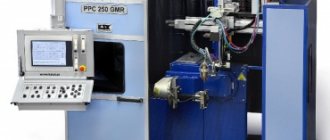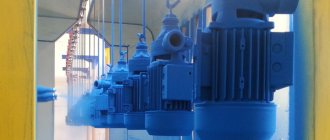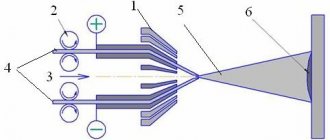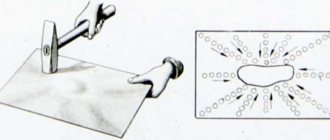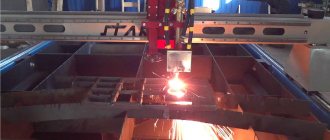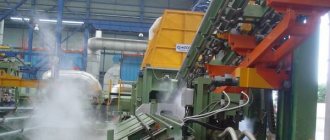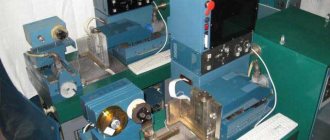Chrome plating is one of the most common methods of protecting metal products from corrosion, as well as their decorative design. Today, there are several technologies for carrying out such a procedure, for the implementation of which various equipment for chrome plating is used.
DIY chrome valve cover
Description of the basic operating principle
Now we sell equipment for chrome plating, both domestic and foreign. Foreign developments are distinguished by their convenience and efficiency in operation, as well as their compactness. But they are much more expensive than their Russian counterparts.
As for the configuration, it usually consists of:
- working stand;
- pressure gauges (preferably a whole set);
- spray bottle;
- pistol
It is these parts that carry out both the blowing of products for processing and other work processes. Domestic analogues are much cheaper. But they often lack the ability to perform decorative finishing.
When such equipment is used for chrome plating, the description of the process will look like this:
- Any paintwork previously applied must be completely removed. Any contamination must be removed. Grinding and degreasing are carried out.
- After this, move on to the primer layer.
- Heat treatment of products helps improve adhesion to other materials.
- The next step is to use a spray gun to apply the chrome layer.
- Varnish or self-adhesive film is used to provide additional protection.
Thus, the metal receives maximum protection from corrosion processes. Chemical metallization also helps to cope with this problem. It is performed with special reagents, which are also used in the chrome plating process. The procedure promotes the formation of a thin layer of chromium. The main characteristic is a high level of protection. Just like the chrome plating equipment itself.
On video: equipment for chemical metallization.
What is chemical metallization? DIY chemical metallization:
Effective protection and decoration is a very relevant topic both for large-scale production and for the home craftsman. One of the most popular methods for solving these problems is chemical metallization. It is widely used in production, and is also done by hand.
Types of metallization
Metallization is the application of a thin metal layer to a surface. This way not only metal products can be processed, but also plastic, wood, glass and others.
The most popular and well-known types of this process are chrome plating (that is, metallization with chromium) and galvanizing (when the surface of the product is coated with a layer of zinc).
A lesser known type is aluminizing (applying a layer of aluminum to the surface). Depending on the equipment and technology, there are several types of metallization:
- Galvanic. It is performed in a special electrolyte, which is poured into baths.
- Electric arc metallization. The coating here is applied in the following way: electric arc melting of a metal electrode is used.
- Gas plasma spraying technology is similar to electric arc metallization, when molten, finely dispersed metal is applied to the surface. Gas plasma spraying, like electric arc metallization, is a rather complex technological process, so it is used mainly in production.
- Cladding. In this method, a layer of metal is applied to the surface of the product, after which hot rolling is applied.
- Metallization is diffuse. High temperature causes atoms of the applied metal to penetrate the surface of the workpiece.
- Hot type of metallization. The coating is formed when the product is immersed in molten metal.
- Chemical metallization. This type is perfect for use at home.
Pseudo-chrome plating and real processing
Using paint that contains up to 75 percent chromium is one of the simplest metal processing options. But this decision does not apply to metallization in the full sense of the word. They simply use paint on the surface of the product that requires treatment.
With this method of chrome plating, an ordinary paint brush or spray bottle will become indispensable assistants. However, there is also chrome spray paint on sale, which simplifies the painting process.
If the work is done according to all the rules, the result will last for at least five years. This result is achieved by any chrome plating installation. But, if such a layer is damaged, then corrosion will quickly begin to penetrate inside the product.
If you carry out truly effective metallization with your own hands, then you need to use:
- source of direct electric current;
- electrolyte for chrome plating;
- a special container where galvanic processes will take place.
This is a minimum set, without which chrome plating becomes completely impossible.
DIY chemical metallization at home
To protect parts of various mechanisms or parts of metal structures from corrosion, giving them additional wear resistance, hardness and improving the aesthetic appearance, chrome or nickel plating is used.
These methods involve applying a chemically inert coating of chromium or nickel to the surface of structures, improving aesthetics. Applying such a film is an energy-intensive process. Technologically, it is complex, but it provides protection for many decades without any noticeable loss to appearance.
Often there is a need to cover with a decorative film those products that were not initially subjected to the chrome plating process. Thus, if desired, you can, for example, change the appearance of the sculpture and make the interior of any living space modern.
You can decorate your car or motorcycle to your liking. It’s not at all difficult to do this even with your own hands, that is, without using complicated technologies.
It is possible to apply a chrome film even on structures with complex relief, and not just convex, flat or concave ones.
Basic methods of chrome plating
- Chemical metallization process.
- Galvanization.
- Vacuum spraying.
- High temperature diffusion.
The last two methods are used only in industrial enterprises.
These processes cannot be performed at home, since they require technically complex installations and increased energy costs. But chemical metallization and galvanization are exactly the same processes that can be carried out in a personal workshop.
Let's take a closer look at how this is done.
Chemical metallization of surfaces and parts
In the process of this work, chemical reagents, a compressor and a spray gun are used. Almost the same operations are performed as when painting surfaces with acrylic varnish or enamel.
When chrome plating in this way, not a protective polymer film is applied to parts and structures, but a mirror-like thin layer of metal. Its thickness is in the range of 0.075-0.25 millimeters. The chemical and physical characteristics of such a coating are comparable to those obtained by vacuum deposition.
How to perform chemical metallization
1st method. The surface is coated with special chemicals. As a result of the chemical reaction, a precipitate is formed, which is a durable metal layer. The coating can be made not only from chrome, but also from silver.
2nd method. During the process of a reducing chemical reaction, a layer of chromium is formed from the salts. Prepare a set of acetic acid, chromyl chloride, chromium chloride, chromium acetate, sodium hyposophite, sodium hydroxide, chromium phosphate. It must be remembered that these substances are very toxic and hazardous to health.
And therefore, you should carefully study the chemistry textbook if you decide to carry out the chrome plating process using this method. But achieving high quality is very difficult, even with detailed instructions. Despite all the existing disadvantages, this method is most often used for chrome plating surfaces in home workshops.
It is very convenient to carry out the plating process using ready-made test kits of chemicals for chrome plating. They are offered by Fusion Technologies.
The convenience of such kits is that the coating can be applied to any of the listed materials: metal, ceramics, wood, glass, plastic. Galvanic installations and special complex equipment are not required.
All you need is a spacious room, distilled water, a compressor, a sprayer and a set of chemicals. In addition, you need to prepare a gas burner with a gas cylinder.
Safety regulations:
- Ventilation device in the workshop. Opening doors and windows will not solve the problem. Install an ordinary kitchen fan into the window. This will be enough for amateur work. If you plan to work on a private enterprise scale, chrome plating a large number of spare parts for cars, decorative interior items, then you will need to install more efficient and powerful ventilation.
- Sewage equipment. The work will require large amounts of water to wash parts. Additional cleaning is not necessary, since it is chemically inert. But the drainage into the sewer canal must be equipped.
- In order not to expose the respiratory system and skin to dangerous effects of reagents, it is recommended to work with the use of protective equipment. Stock up on respirators, special safety glasses and a durable apron. You will also need several pairs of rubber gloves.
When performing chemical metallization in your personal workshop, do not forget about strict adherence to technology. Reagents should be applied to the surface in the specified order.
This is followed by the application of a thin layer of silver. This metal is safe, unlike chromium and compounds. The finishing layer is in no way inferior to chrome in terms of characteristics.
A set of reagents for metallization consists of modifiers A and B, a reducing agent and an activator. At the very beginning of work, the reagents are diluted in the specified volume of distilled water. Proportions are strictly observed. Solutions should be stored in a cool place. You can buy the varnishes and pigments necessary for the work at the same store where you bought the reagents.
Work order:
- Preparation of a part or structure. The surface should be thoroughly cleaned. It should be as smooth as possible. This is done by polishing.
- The varnishing process is then carried out using a varnish designed for this purpose.
- When the varnish is completely dry, the surface is treated with a gas torch. This technological process changes the structure of the varnish at the molecular level. This is done to increase absorption and adhesion for the metallized coating.
- Following the heat treatment, the activator is sprayed. Excess activator is quickly washed off with water.
- While the surface is still wet, a modifier is applied, followed by a solvent. The reaction between them leads to the formation of the necessary mirror coating layer. Again, the product is washed with water and dried with a directed stream of air.
- The metallization process takes about six hours. After this, in accordance with the technology, the part is varnished. The effect of bronze, chrome or gold is achieved by adding appropriate pigments to the varnish. If you decide to chrome parts at home and with your own hands, order all the necessary chemicals on the company’s website. If necessary, specialists will provide qualified assistance and suggest suitable options for installing equipment in your home workshop.
Chemical chromium plating technology
The algorithm for chrome plating, which is carried out by galvanization, can be described as follows:
- The product for processing is placed in a special bath, which is pre-filled with electrolytic solutions.
- Afterwards everything is connected to the current source, with a plus sign.
- Any chromium-based workpiece is connected to the negative contact at the power source.
- The chrome billet absorbs the electricity. It goes into the electrolyte, to an additional product. Next, the ions that make up chromium are separated. They are passed through the surface of the electrolyte, and then taken over by the part being used. It is sometimes difficult to get a set with them.
- Chromium ions settle on the surface and bind to it at the molecular level. The result is the formation of a layer that provides maximum protection.
It is the chemical type of metallization that contributes to the creation of the most reliable protective layer.
This technology allows you to apply a layer of not only chromium to the surface, but also of other metals, including: aluminum, silver, zinc. The installation for chemical metallization remains the same. It is important to use a suitable current source, then the speed of the process for chrome plating parts will be appropriate.
But we must remember that the process of chemical metallization involves the release of substances harmful to human health. Therefore, to carry out the procedure in a domestic environment, only non-residential premises should be used. Personal protective equipment will also not be superfluous.
Equipment for chrome plating - what you need to apply chrome
Chrome plating is one of the most common methods of protecting metal products from corrosion, as well as their decorative design. Today, there are several technologies for carrying out such a procedure, for the implementation of which various equipment for chrome plating is used.
Principle of operation
On the modern market you can purchase both foreign and domestic equipment for chrome plating. The first, although compact, convenient and efficient in operation, is quite expensive.
The set of such equipment includes a working stand, a set of pressure gauges, a spray gun and a gun, with which the workpiece is blown.
Domestic equipment used for chrome plating of parts costs much less than foreign equipment, but does not allow decorative processing (with its help you can only imitate its results).
Professional installation for chemical chrome plating. All controls and controls are conveniently located on the front panel
Chrome plating when using such equipment is performed as follows:
- Before chrome plating, the surface to be treated is cleaned of paint and varnish coatings, any contaminants, sanded and degreased.
- Then a layer of primer is applied to it.
- To improve the adhesion of the applied primer to the metal, the latter can be subjected to heat treatment.
- After this, a layer of chromium is applied to the surface of the cooled product using a spray gun.
- To protect the coating applied as a result of chrome plating, you can use varnish or self-adhesive film.
A coating applied in this way cannot provide reliable protection of the metal from corrosion. Chemical metallization, performed using special chemical reagents for chrome plating, can effectively solve this problem. As a result of this procedure, a thin layer of chromium is formed, characterized by high protective properties.
The difference between pseudo-chrome plating and real chrome plating
The simplest method of chrome plating, which cannot be considered full metallization, involves the use of paint containing at least 75% chrome dust.
Metal-containing paint is applied to the surface of a cold product (for this, use a spray gun or a regular paint brush). Thus, a kind of barrier is created that protects the metal from corrosion.
The result of such chrome plating, if done correctly, can last at least five years. However, if the coating is damaged, corrosion will affect not only the surface of the metal, but also its deep layers.
Truly effective chemical metallization involves the use of:
- a special container in which galvanic processes take place;
- electrolyte for chrome plating;
- source of constant electric current.
This set of accessories and consumables is the minimum for chrome plating.
A complete set of chrome plating equipment also includes degreasing and washing baths, an oil separator and drying chambers.
Application of chromium in production conditions
The algorithm for the standard chrome plating procedure performed under production conditions is as follows.
- The workpiece is placed in a bath filled with an electrolytic solution.
- It is then connected to the positive contact of the electrical current source.
- Any workpiece made of chromium is connected to the negative contact of the current source.
- After the electric current begins to flow to the chromium workpiece, to the workpiece and into the electrolyte, chromium ions will begin to separate from the workpiece and move through the electrolyte to the workpiece.
- By settling on its surface and bonding with it at the molecular level, chromium ions form a reliable and very durable protective layer on it.
Chemical metallization allows you to form the most reliable coating, characterized by high protective properties. Using this technology, a layer of not only chromium, but also zinc, silver, aluminum and other metals can be applied to a metal part.
It should be borne in mind that chemical metallization is accompanied by the release of chemicals harmful to health, therefore, if you are planning to carry it out at home, you must use only non-residential premises.
Naturally, personal protective equipment should not be neglected.
To ensure a uniform rate of chemical reaction, to independently perform chemical metallization, it is necessary to correctly select a source of direct electric current.
Thermochemical metallization technology
In the recent past, metal gilding was carried out using thermochemical metallization technology. The essence of this technology, the use of which makes it possible to apply coatings not only of gold, but also of other metals, to the surface of a product, is as follows:
- A special composition consisting of metal dust and a binder made from wood resins is applied to the metal.
- After the applied layer has completely dried, the product is placed in a muffle furnace.
- Under the influence of the high temperature created inside the furnace, the binder composition burns out, and the metal dust melts, forming a thin protective layer.
Today there are several variations of this technology. The first of them is that the metal layer is applied under high pressure, while the product itself is in a furnace heated to the required temperature.
Another option for metallization involves that a layer of metal is first sprayed onto the surface to be treated, and then the product is fired in a furnace.
Thermochemical metallization
At the end of the last century, gilding of metal was carried out using thermochemical metallization technology.
This is another way to apply metal coatings for additional protection. Its main features, as well as for the equipment for chemical metallization itself, are as follows:
- A special composition is applied to the metal, in which metal dust is combined with a binder component. It is usually based on wood resins. Their selection varies.
- The product is placed inside a muffle furnace when the raw materials harden.
- Inside this structure, a sufficiently high temperature is maintained, when exposed to which the connecting element simply begins to burn out. Metal dust melts. Thus, a dense layer is formed for additional protection.
This chemical metallization is currently used in several variations. The first of them is based on the main principle according to which a layer of metal is applied to the surface of the product while constantly maintaining high pressure. The product itself is located inside an oven heated to a certain temperature.
An option is possible when a layer of metal is pre-sprayed onto the surface of the product. After this, the product is placed in a kiln for firing.
This chemical metallization is also available in a more simplified, home version:
- Metal dust is applied to the surface in one layer.
- Melt the dust using a regular construction hair dryer. This promotes the formation of a thin layer on the surface.
- Grinding and subsequent polishing with your own hands allows you to make the surface as smooth and even as possible, meeting all requirements.
Chemical metallization by this method requires the use of the following materials and technologies:
- composition for finishing coating;
- a machine with which everything is polished;
- hair dryer to create a flow of air with increased temperature;
- spray bottle for applying metal powder.
A set of tools is easy to obtain in a specialized store.
Chemical metallization - how to protect the coating?
Those who are interested in the protection of alloys and decorative coating are probably interested in the question: is chemical metallization feasible at home? Let's talk about this in more detail.
What is metallization technology and in what cases is it carried out? As the name implies, this process involves applying a metal layer to the surface.
Moreover, the base material can be either metal or non-metal (wood, glass, etc.).
Depending on the coating, there are: the most popular galvanizing process (a layer of zinc is applied), chemical chrome plating (a layer of chromium), aluminizing (aluminum coating), which is not familiar to everyone.
What about application methods, they can also be very different, depending on what equipment is used. Electroplating is widely used, where the workpiece is placed in a bath of electrolyte.

